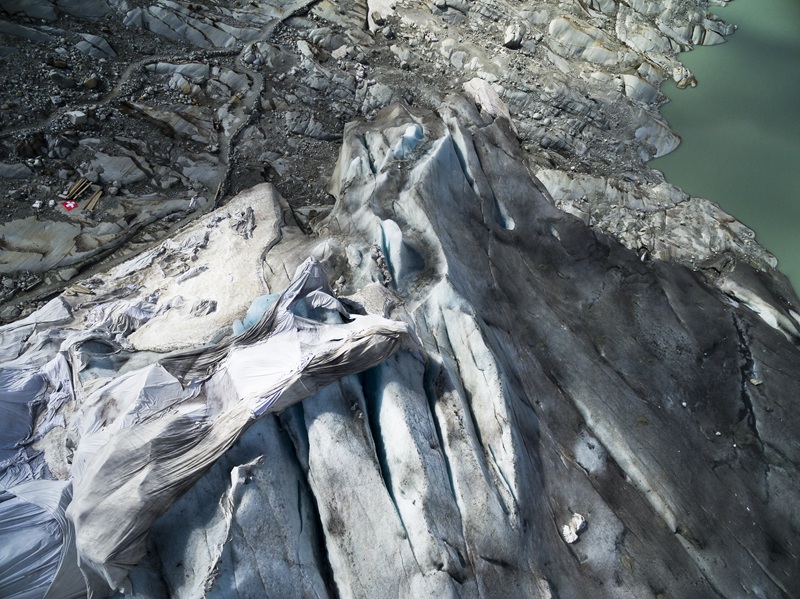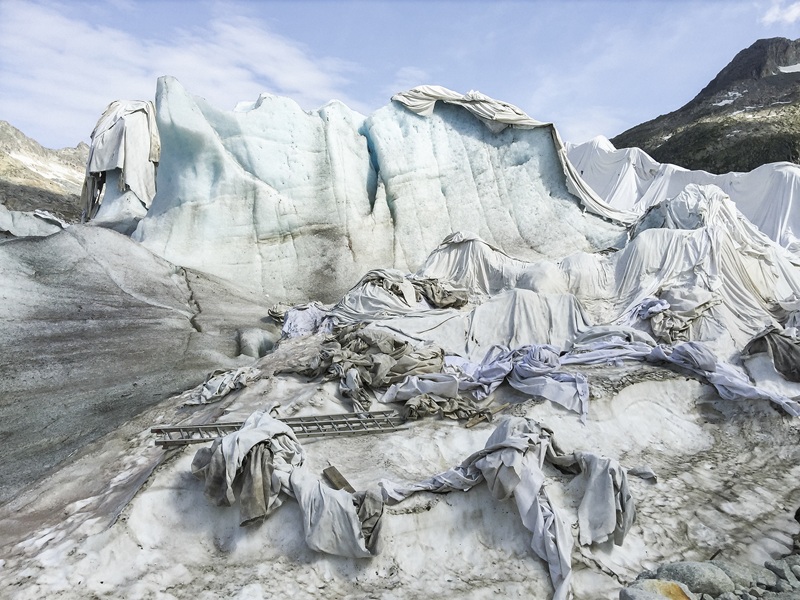
Jacques Pugin
The glaciers are melting, the cities are transforming, and through it all, Pugin’s camera captures the fragility and resilience of the landscapes that define his homeland.
“Over the decades, I have observed several significant changes in the Swiss landscape, both ecologically and culturally,” he reflects. “One of the most notable changes is the visible impact of climate change on the alpine glaciers, which are retreating at an alarming rate. This has dramatically transformed the iconic alpine landscape of Switzerland. These ecological changes have made me more aware of the fragility and ephemeral beauty of our natural environment, and they have inspired my photographic approach, which aims to create portraits and observations of nature that capture these changes. I seek to raise awareness of these issues through my work, fostering discussions and inspiring actions to protect our planet.”

#12 Graffiti rouges

#05 Graffiti rouges
This sentiment resonates throughout Pugin’s work, where the intersection of time, nature, and memory creates a narrative of constant elaboration. His lens serves not merely as a tool for documenting landscapes but as a means of bearing witness to the silent yet inevitable passage of time. In his perspective, art does not alter the passage of time; rather, it shapes our perception of it.
Art has the power to impact how we perceive time and how we step back to put effects into perspective,” Pugin says. “A piece of art can invite the viewer to slow down, reflect, and maybe reconsider their relationship with time.
One needs to look no further than his iconic Graffiti Greffés series, where he steps away from traditional photography to explore the dynamic relationship between light and space. In this groundbreaking work, he employed “light painting,” a technique that allows the artist to produce images by directly manipulating light sources. He explains, “I was one of the first to use this technique, and it was incredibly liberating. Unlike traditional photography, where light is captured as it reflects off of objects in a scene, light painting allows me to draw directly in space, creating forms and patterns that aren’t constrained by the physical limitations of objects. It’s an act of creation in real-time, and there’s something deeply freeing about that.”
The shift from traditional photography to more experimental forms is a hallmark of Pugin’s career. He speaks passionately about how each medium informs his vision and how he has constantly sought new technologies to push the boundaries of his work. From analogue and digital photography to homemade methods and, more recently, satellite imagery, his development as an artist has been guided by the tools at his disposal. “Each medium has its own characteristics and expressive possibilities that can enrich the work’s message,” he notes. “Satellite imagery, for instance, has opened up a whole new world of global perspectives. It’s allowed me to see my subjects from a macro perspective, to approach them with a scale and scope that would have been impossible with traditional photography.”
Unsurprisingly, one of Pugin’s recent projects, Cavalier du Diable, was born directly from the medium. He smiles, his eyes glinting with that familiar spark of curiosity. “The idea for that series came directly from the medium. It was the technology that dictated the form the work would take.”
However, while technology plays a crucial role in his artistic development, he insists that it is the ideas themselves that ultimately guide his work. He argues that the choice of medium is secondary. “In some cases, it’s the idea that takes precedence, and the medium follows. In other cases, the medium comes first, and the idea evolves around it. But in the end, they are inextricably linked.”

#02 Graffiti rouges

#19 Grafted graffiti
His creative process is an intimate engagement with the landscape. His work is physical, grounded in the acts of walking, waiting, and returning to the same places over time. This slow, deliberate interaction with nature is central to his process. “Walking allows me to immerse myself in the environment. It puts me in the right mindset to create. Waiting is just as important; it’s about observing the changes that come with time, whether it’s movements in nature or the impact of climate change. These moments of stillness are when the landscape reveals its true spirit.”
As an artist, Pugin has a special connection to Switzerland’s forgotten places—those sites that time has abandoned but memory has not. He captures these locations with reverence, seeing in them not just remnants of history but metaphors for the impermanence of all things. “Forgotten places are powerful,” he reflects. “They are repositories of stories, of histories. They remind us of the inevitable decay of everything we build. It’s a reminder that nothing lasts forever, and that’s what gives them their beauty.”
His photographs of these forgotten places serve as quiet yet powerful meditations on the passage of time, a recurring theme in much of his work. “Photographing these places reminds us of the fragility of life, of the transience of our existence. It’s an invitation to reflect on what might be lost or disappear if we don’t pay attention.”
Due to his deep engagement with the natural world and the passage of time, Pugin’s photographic approach is not limited to documenting reality; rather, it focuses on creating meaning. His work encourages observers to slow down, view the world through a different lens, and reflect on how our landscapes shape and are shaped by the flow of time. His advice for young photographers and artists? “Everyone must find their quest, their path. Stay true to yourself, listen to your sensitivity. Creation should always be a source of joy.”
Switzerland becomes a living, breathing reflection of his inner world, a landscape where time and memory converge in Pugin’s work. It serves as a call to action, reminding us that the beauty we witness today may be lost tomorrow if we do not learn to protect it.

#015 Glaciers, Rhonegletscher

#001 Glaciers, Rhonegletscher
Jacques Pugin’s works will be on view at Photo Basel from June 17 to 22, presented by Galerie Esther Woerdehoff.
author ANASTASIA YOVANOVSKA
images COURTESY OF JACQUES PUGIN

